

The development of a uniform system of buoyage throughout the world was of paramount importance for safe navigation at sea. As traffic lights are used to guide drivers on road, similarly buoys and beacons are indispensable for guiding mariners at sea.
Imagine what would have happened if more than one buoyage system was in use around the world. Different buoyage system means different rules, in complete conflict with one another. It would cause confusion and lead to accidents.
With the aim of improving navigational safety to act as a barrier to dangers to shipping and to solve differences of opinions, efforts were made to establish a single set of rules by IALA – INTERNATIONAL ASSOCIATION OF MARINE AIDS TO NAVIGATION AND LIGHTHOUSE AUTHORITIES, which gave them a choice of using red to port or red to starboard, on a regional basis.
For the sake of maintaining uniformity in buoyage system worldwide, IALA divided the world into two regions – Region A and Region B.
Region A includes Europe, Australia, New Zealand, Africa, the Gulf and some Asian countries whereas Region B comprises of North, South, Central America, Japan, Korea and the Philippines.
IALA proposed a system allowing the use of lateral marks in each region, but whereas in region A, the colour red of the Lateral System is used to mark the port side of channels and the colour green for the starboard side.
In region B, the colours are reversed. Regional variations do not pertain to cardinal, isolated danger markings, safe watermarks or special marks.
IALA buoyage system provides six types of marks:
• Lateral marks
• Cardinal marks
• Isolated danger Marks
• Safe Water Marks
• Special Marks
• Emergency Wreck Marking Buoy
1. LATERAL MARKS: The lateral marks help to indicate which side of the waterway is to be followed. The port marks should be kept to the vessel’s left side and starboard marks to its right.
However, when a vessel travels downstream, the position of marks will change accordingly, i.e. port marks on its right side while starboard marks on its left.
When a channel divides to form more than one way, a modified lateral mark is then used to indicate the “preferred channel”. A preferred channel is indicated by red and green horizontal bands on the lateral mark.
If you find that the marks are numbered, it indicates that the sequence follows the conventional direction of buoyage.
Every buoy is identified by their colour, shape, top marks, light and the rhythm of light.
The table below will give a better illustration of the buoys found in Region A and B respectively.
LATERAL MARKS REGION A:
| PORT HAND MARKS | STARBOARD HAND MARKS | |
| COLOUR | RED | GREEN |
| BUOY SHAPE | CYLINDRICAL(CAN), PILLAR, SPAR | CONICAL, PILLAR, SPAR |
| TOPMARK | SINGLE RED CYLINDER(CAN) | SINGLE GREEN CONE POINTING UPWARD |
| LIGHT COLOUR | RED | GREEN |
| LIGHT RYTHM | ANY APART FROM COMPOSITE GROUP FLASH (2+1) | ANY APART FROM COMPOSITE GROUP FLASH (2+1) |
| PREFERRED CHANNEL TO STARBOARD | PREFERRED CHANNEL TO PORT | |
| COLOUR | RED, GREEN, RED HORIZONTAL STRIPES | GREEN, RED, GREEN HORIZONTAL STRIPES |
| BUOY SHAPE | CYLINDRICAL(CAN), PILLAR, SPAR | CONICAL, PILLAR, SPAR |
| TOPMARK | SINGLE RED CYLINDER(CAN) | SINGLE GREEN CONE POINTING UPWARD |
| LIGHT COLOUR | RED | GREEN |
| LIGHT RYTHM | COMPOSITE GROUP FLASH (2+1) | COMPOSITE GROUP FLASH (2+1) |
LATERAL MARKS REGION B:
| PORT HAND MARKS | STARBOARD HAND MARKS | |
| COLOUR | GREEN | RED |
| BUOY SHAPE | CYLINDRICAL(CAN), PILLAR, SPAR | CONICAL, PILLAR, SPAR |
| TOPMARK | SINGLE GREEN CYLINDER(CAN) | SINGLE RED CONE POINTING UPWARD |
| LIGHT COLOUR | GREEN | RED |
| LIGHT RYTHM | ANY APART FROM COMPOSITE GROUP FLASH (2+1) | ANY APART FROM COMPOSITE GROUP FLASH (2+1) |
| PREFERRED CHANNEL TO STARBOARD | PREFERRED CHANNEL TO PORT | |
| COLOUR | GREEN, RED, GREEN HORIZONTAL STRIPES | RED, GREEN, RED HORIZONTAL STRIPES |
| BUOY SHAPE | CYLINDRICAL(CAN), PILLAR, SPAR | CONICAL, PILLAR, SPAR |
| TOPMARK | SINGLE GREEN CYLINDER(CAN) | SINGLE RED CONE POINTING UPWARD |
| LIGHT COLOUR | GREEN | RED |
| LIGHT RYTHM | COMPOSITE GROUP FLASH (2+1) | COMPOSITE GROUP FLASH (2+1) |








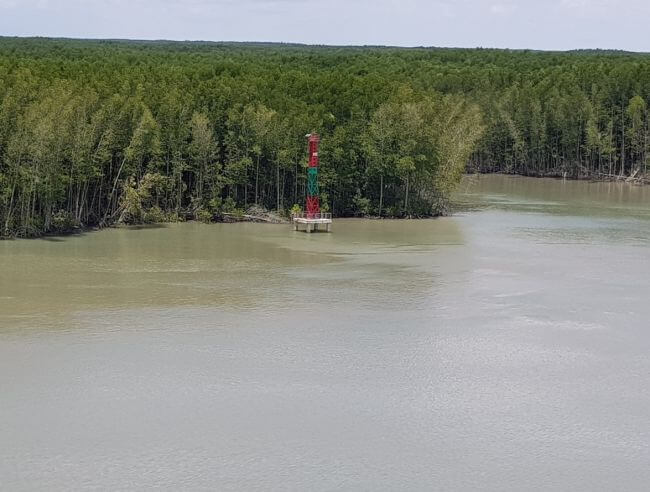



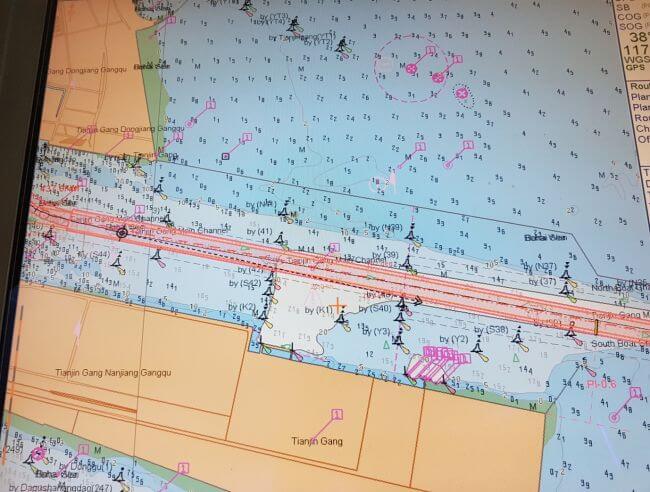



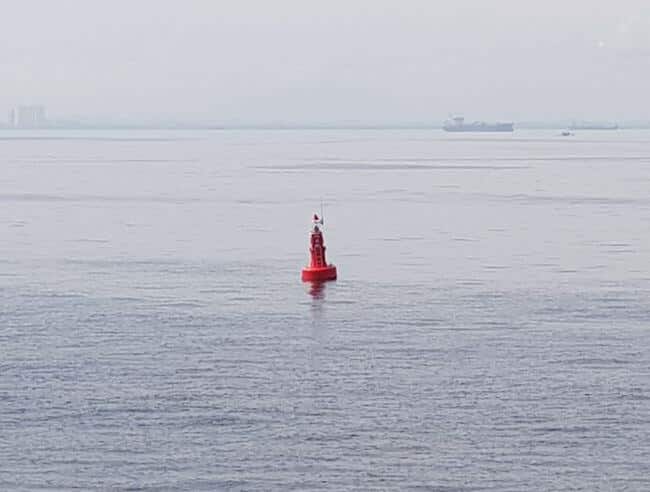







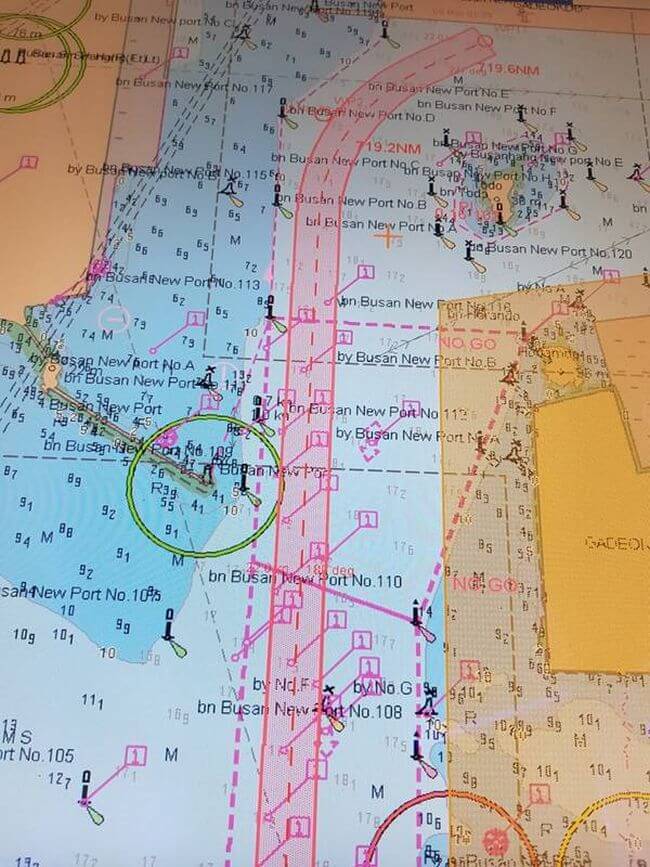

2. CARDINAL MARKS :
Cardinal marks are used in conjunction with the compass to indicate where the mariner may find the best navigable water. They take their name from the quadrant in which they are placed. They have the same colour and same shape irrespective of the regions A and B.
There are 4 cardinal marks named after the four cardinal points of the compass; NORTH, SOUTH, EAST AND WEST. Each mark can be distinguished from one another from their top marks, buoy colour and rhythm of light. When a cardinal mark is seen, remember that clear and navigable water lies on the named side of the mark.
So suppose that you are on an easterly course and you see a north cardinal mark ahead of you, it should strike to your mind that safe navigable water is on the north side of the cardinal mark, and therefore you should alter your course to port. Cardinal marks are also used to draw attention to a feature in a channel such as a bend, junction, branch or end of a shoal.
Remembering the buoys and its top marks is not a challenge if you commit these key points to memory- North and South cardinal top marks are pretty easy to remember as they follow the direction North and South.
North cardinal top marks point upwards while the south top marks point downwards. East cardinal top mark pretty much takes the shape of an egg and can be associated with the Easter egg. West cardinal top mark can be compared to the waist of a woman – tapering towards the centre.
The rhythm of light can be related to the face of a clock. All cardinal marks exhibit white light. The table below describes the light rhythm for each cardinal mark.


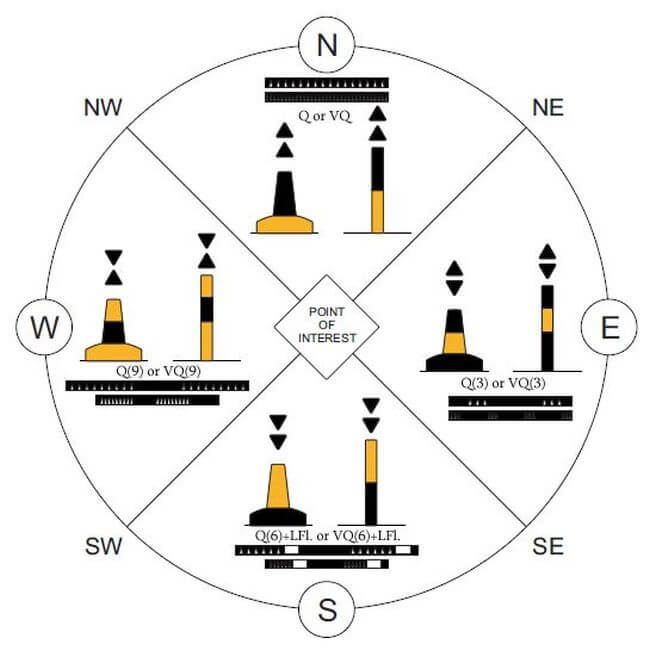

| NORTH CARDINAL MARK | EAST CARDINAL MARK | |
| COLOUR | BLACK ABOVE YELLOW | BLACK WITH A SINGLE HORIZONTAL YELLOW BAND |
| BUOY SHAPE | PILLAR OR SPAR | PILLAR OR SPAR |
| TOPMARK | 2 BLACK CONES POINTING UPWARDS | 2 BLACK CONES, BASE TO BASE |
| LIGHT COLOUR | WHITE | WHITE |
| LIGHT RYTHM | VQ OR Q (UNINTERRUPTED) | VQ (3) OR Q(3) |
| SOUTH CARDINAL MARK | WEST CARDINAL MARK | |
| COLOUR | YELLOW ABOVE BLACK | YELLOW WITH A SINGLE HORIZONTAL BLACK BAND |
| BUOY SHAPE | PILLAR OR SPAR | PILLAR OR SPAR |
| TOPMARK | 2 BLACK CONES POINTING DOWNWARDS | 2 BLACK CONES, POINTING TOWARDS EACH OTHER |
| LIGHT COLOUR | WHITE | WHITE |
| LIGHT RYTHM | VQ(6) + LONG FLASH OR Q(6) + LONG FLASH | VQ (9) OR Q(9) |
Note that Quick flashing light (Q) has a flash frequency of 50 to 60 flashes every minute and a Very Quick flashing light (VQ) has a flash frequency of at least 100 to 120 flashes every minute.
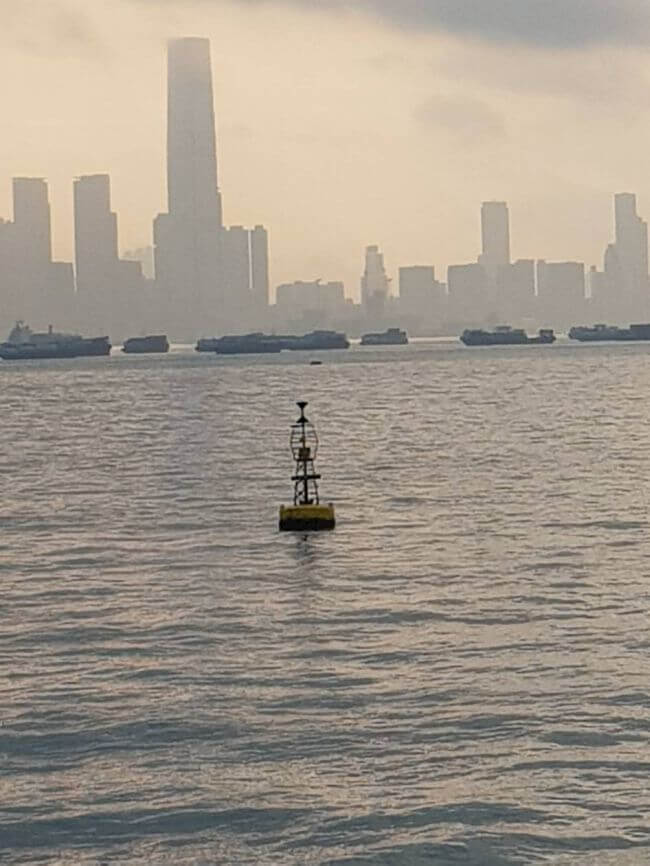

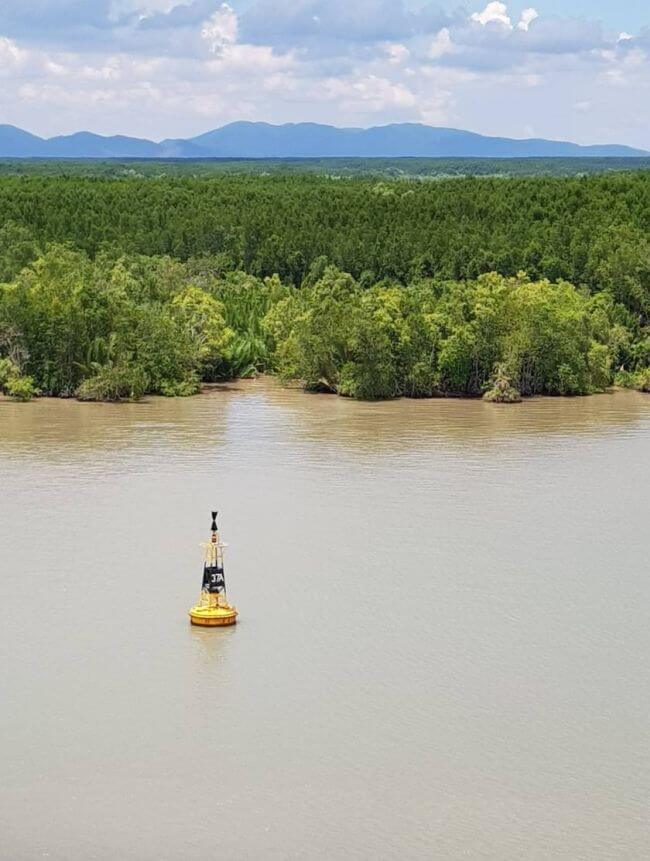

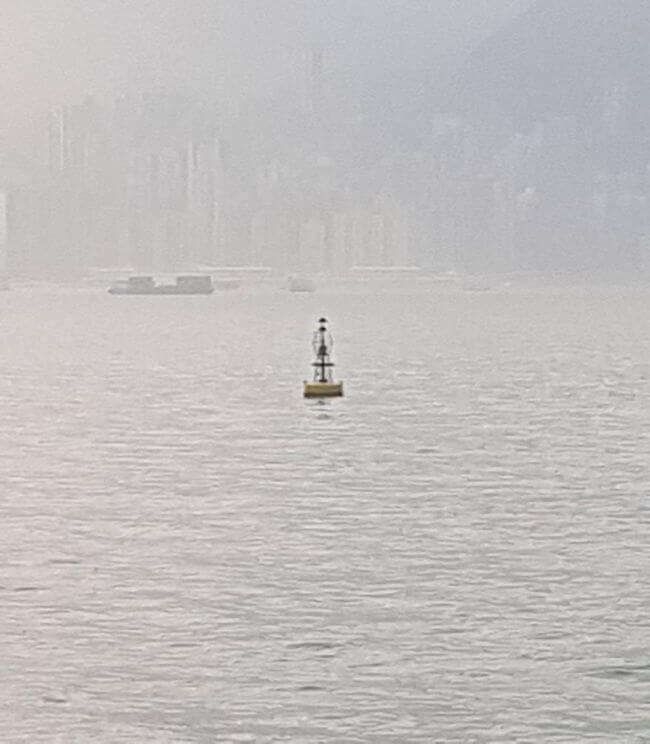







3. SAFE WATERMARKS:
Unlike other marks that use horizontal stripes, this is the only mark to use vertical stripes. Safe watermark does not point to any danger but specifies that safe navigable water is all around the mark.
Safe water marks are instrumental to mariners as they indicate the beginning of a marked channel. So when a mariner sees a safe watermark on a chart, he should soon realize that he is approaching a channel.
It is the demarcation between open sea waters and confined waters. It indicates the entrance to any port. It also points out the best point of the passage under a fixed bridge.
Safe watermark uses a red ball as a top mark. Safe watermarks can be used in a line to mark navigable safe water route through shallow areas.
| SAFE WATERMARK | |
| COLOUR | RED AND WHITE VERTICAL STRIPES |
| BUOY SHAPE | PILLAR, SPAR, SPHERICAL |
| TOPMARK | SINGLE RED SPHERE |
| LIGHT COLOUR | WHITE |
| LIGHT RHYTHM | ISOPHASE, OCCULTING, 1 LF EVERY 10 SECS OR MORSE CODE ‘A’ |


4. ISOLATED DANGER MARKS:
As the name suggests, these buoys are used to mark dangers to shipping. They highlight and bring to the attention of mariners any hazards or dangers to safe navigation.
These marks are erected or moored above the danger to alert mariners of any peril ahead. An isolated danger mark indicates that there is navigable water all around the mark.
These marks can be distinguished from other marks by their top marks, which consist of 2 black spheres one above the other and by their colour – black with one or more red horizontal bands. The rhythm of light, group flashing 2 can easily be retained in memory by correlating to its top mark -2 black spheres.


| ISOLATED DANGER MARK | |
| COLOUR | BLACK WITH ONE OR MORE RED HORIZONTAL BANDS |
| BUOY SHAPE | PILLAR OR SPAR |
| TOPMARK | 2 BLACK SPHERES, DISPOSED of VERTICALLY |
| LIGHT COLOUR | WHITE |
| LIGHT RYTHM | GROUP FLASHING 2 |
5. SPECIAL MARK:
Special marks are used to denote mariners’ areas with special features. They do not play any major role in facilitating mariners in safe navigation. They only point out areas of certain interests to mariners. The nature of such areas can be found by consulting the charts or Sailing Directions.
Special marks may indicate spoil grounds, military exercise areas, recreational zones, boundaries of anchorage areas, cables and pipelines, Dead ends, mooring areas, protected areas, marine farms or aquaculture, oil wells, ODAS(Ocean Data Acquisition System) which gather information about wind speed, pressure, salinity and temperature.
These marks can easily be demarcated from other buoys by their yellow colour and topmark which is a cross.
| SPECIAL MARK | |
| COLOUR | YELLOW |
| BUOY SHAPE | OPTIONAL BUT MUST NOT CONFLICT WITH THAT USED FOR A LATERAL OR SAFE WATERMARK |
| TOPMARK | SINGLE YELLOW CROSS – ‘X’ SHAPED |
| LIGHT COLOUR | YELLOW |
| LIGHT RYTHM | ANY RHYTHM NOT USED FOR WHITE LIGHT |


6. EMERGENCY WRECK MARKING BUOY:
These buoys have come into existence much later compared to the other 5 types of marks. The sinking of the MV Tricolour in the Dover Strait in 2002 introduced the emergency wreck marking buoy in the IALA buoyage system.
The wreck was struck further by 2 other ships causing havoc damage to shipping and loss of life. Post this incident, it was immediately necessary to mark such new dangers so that it is readily recognized by ships as a new hazard and further collisions are prevented from occurring.
Emergency wreck marking buoys mark newly discovered unsurveyed dangers which are yet to be announced and declared in nautical publications and charts.
This buoy is placed as close as possible to the wreck and unlike other buoys, is designed to provide a highly conspicuous visual and radio aid to navigation.
| EMERGENCY WRECK MARKING BUOY | |
| COLOUR | YELLOW AND BLUE STRIPES – MINIMUM 4 MAXIMUM 8 |
| BUOY SHAPE | PILLAR OR SPAR |
| TOPMARK | UPRIGHT YELLOW CROSS + |
| LIGHT COLOUR | YELLOW |
| LIGHT RYTHM | ANY RHYTHM NOT USED FOR WHITE LIGHT
B 1.0S + 0.5S + Y 1.0S + 0.5S |


Had IALA not emerged with the idea of having a uniform, single buoyage system worldwide, there would have been lots of confusion and conflict among seafarers navigating all over the world and safety of navigation would be jeopardized.
IALA maritime buoyage system has helped to overcome these difficulties to a great extent s thereby aiding mariners of all nationalities, navigating anywhere in the world to fix their position and avoid dangers without fear of ambiguity, now and for the years to come.
IALA which is a non-governmental body has worked dedicatedly over the years to exchange information and recommend improvements to navigational aids based on the latest technology.
The implementation of IALA buoyage system began in the 1980s. Still many of the countries across the globe remain to adopt and follow the IALA system. The change to the new system, although gradual is happening slowly.
Disclaimer: The authors’ views expressed in this article do not necessarily reflect the views of The Marine Learners. Data and charts, if used, in the article have been sourced from available information and have not been authenticated by any statutory authority. The author and The Marine Learners do not claim it to be accurate nor accept any responsibility for the same. The views constitute only the opinions and do not constitute any guidelines or recommendation on any course of action to be followed by the reader.
The article or images cannot be reproduced, copied, shared or used in any form without the permission of the author and The Marine Learners.










We believe that knowledge is power, and we’re committed to empowering our readers with the information and resources they need to succeed in the merchant navy industry.
Whether you’re looking for advice on career planning, news and analysis, or just want to connect with other aspiring merchant navy applicants, The Marine Learners is the place to be.